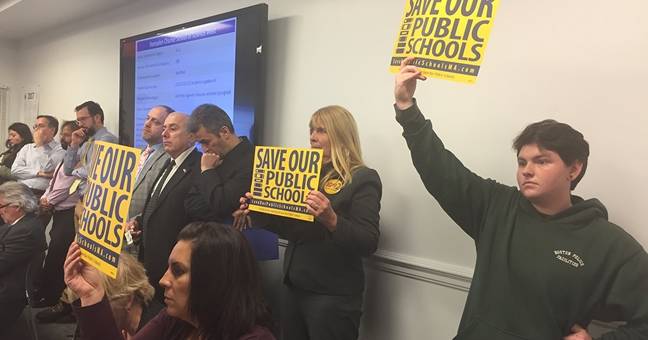BESE votes down expansion of a Pioneer Valley charter school opposed by educators
BESE votes down expansion of a Pioneer Valley charter school opposed by educators

In a rare move, the Board of Elementary and Secondary Education voted 7-2 last night to reject a 452-seat expansion of the Pioneer Valley Chinese Immersion Charter School. MTA President Barbara Madeloni joined education leaders from the Pioneer Valley region in testifying against the expansion, and MTA activists held Save Our Public Schools signs at the BESE meeting in Malden.
Also last night,the board approved the expansion of existing charter schools as well as three new schools.
What follows is Madeloni's testimony given at the BESE meeting on Feb. 27.Testimony by MTA President Barbara Madeloni against expanding the number of seats at the Pioneer Valley Chinese Immersion Charter School in Hadley
Commissioner Chester and members of the board:
Thank you for giving me the chance to speak in strong opposition to the expansion of the Pioneer Valley Chinese Immersion Charter School in Hadley. This expansion would lead to all of the harms discussed by opponents of Question 2, which was defeated on Election Day by an overwhelming 62-to-38-percent vote statewide.
The diversion of funds to this Chinese Immersion Charter School has already been considerable, putting a strain on the public school budgets in Amherst-Pelham, Northampton, and other nearby districts. For example, this year the schools in the Amherst and Pelham region are sending $2.2 million to PVCICS. The huge expansion being considered today would greatly increase the draining of funds from district public schools to a privately run charter school — one that conspicuously fails to serve all students.
As Michael Morris, the school superintendent in Amherst and Pelham, has written to you, the expansion would result in "sending resources from a more diverse to a less diverse student body." For example, of the 11 students who have returned to his region this academic year, 73 percent are students of color and 73 percent are economically disadvantaged. That is worsening the gap that already exists. As the superintendent has noted, 26 percent of the students in his region are economically disadvantaged, while only 13 percent of the students his region sends to PVCICS fall into that category.
In addition, this charter school — like most — does not serve nearly as many special needs students as the sending districts. I am attaching a "Pilot Exit Survey Report and Call to Action" that was presented to the PVCICS Board of Trustees on May 5, 2016, by Christin Glodek. Ms. Glodek was a parent at that school and initially a strong supporter. She became disillusioned when she saw the results of a survey completed by 13 families who had pulled their children out of the school in the previous years. Eleven of the 13 had children who were on an IEP, a federal 504 plan or a Response to Intervention plan. Ms. Glodek wrote: "Of those 11 families, every single one reported that the handling of their child's accommodations was one of the primary reasons that they left the school."
This charter school — like most — does not serve nearly as many special needs students as the sending districts.
This concern isn't just anecdotal; it is bolstered by data. This year, one in five students in the Amherst-Pelham Regional School District are students with disabilities, compared to only one in 17 in the charter. Rather than rewarding this school with an expansion, this board should launch an investigation into whether it is violating the civil and educational rights of its students.
I urge you to listen to the concerns of the parents and educators in the Pioneer Valley and to look closely at how the region voted on Question 2. Consider the districts most impacted: In Amherst, the vote was 77 to 22 against, and in Northampton it was 78 to 22. Elections don't get much more decisive than that. The message is clear. The voters want public funds for their public schools. I believe you have an obligation to decide what is in best interest of all students, families and communities, rather than simply responding to the special interests of the few.